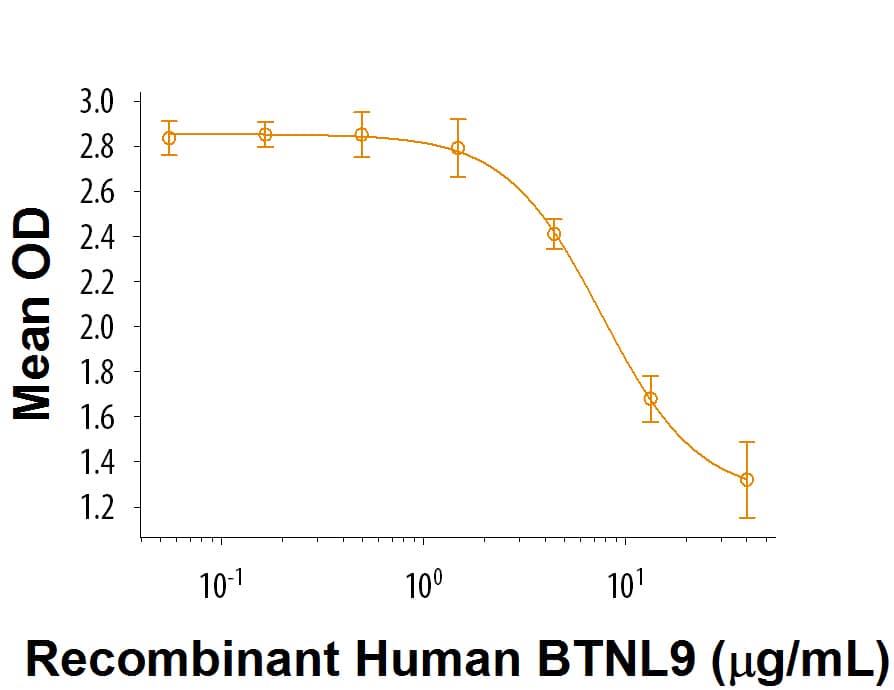Recombinant Human BTNL9 Fc Chimera Protein, CF
R&D Systems, part of Bio-Techne | Catalog # 9659-BT

Key Product Details
Source
HEK293
Accession #
Structure / Form
Disulfide-linked homodimer
Conjugate
Unconjugated
Applications
Bioactivity
Product Specifications
Source
Human embryonic kidney cell, HEK293-derived human BTNL9 protein
| Human BTNL9 (Ser35-Lys256) Accession # Q6UXG8-1 |
IEGRMD | Human IgG1 (Pro100-Lys330) |
| N-terminus | C-terminus |
Purity
>95%, by SDS-PAGE visualized with Silver Staining and quantitative densitometry by Coomassie® Blue Staining.
Endotoxin Level
<0.10 EU per 1 μg of the protein by the LAL method.
N-terminal Sequence Analysis
Ser35
Predicted Molecular Mass
52 kDa
SDS-PAGE
60-69 kDa, reducing conditions
Activity
Measured by its ability to inhibit anti-CD3 antibody induced IFN-gamma secretion by human peripheral blood mononuclear cells (PBMC).
The ED50 fot this effect is 3-15 μg/mL.
The ED50 fot this effect is 3-15 μg/mL.
Scientific Data Images for Recombinant Human BTNL9 Fc Chimera Protein, CF
Recombinant Human BTNL9 Fc Chimera Protein Bioactivity
Recombinant Human BTNL9 Fc Chimera (Catalog # 9659-BT) inhibits IFN-gamma secretion by human peripheral blood mononuclear cells in the presence of anti-CD3 antibody. The ED50 for this effect is 3-15 μg/mL.Formulation, Preparation and Storage
9659-BT
| Formulation | Lyophilized from a 0.2 μm filtered solution in PBS. |
| Reconstitution |
Reconstitute at 200 μg/mL in PBS.
|
| Shipping | The product is shipped at ambient temperature. Upon receipt, store it immediately at the temperature recommended below. |
| Stability & Storage | Use a manual defrost freezer and avoid repeated freeze-thaw cycles.
|
Background: BTNL9
References
- Arnett, H.A. et al. (2014) Nat Rev Immunol. 14:5596.
- Arnett, H.A. et al. (2009) Cytokine 46:370.
- Abeler-Dorner, L. et al. (2012) Trends Immunol. 33:34.
- Rhodes, D. et al. (2016) Annu. Rev. Immunol. 34:151.
- Lebrero-Fernandez, C. et al. (2016) Immun. Inflammation Dis. 4:191.
- Yamazaki, T. et al. (2010) J. Immunol. 185:5907.
Long Name
Butyrophilin-like 9
Alternate Names
BTN3, VDLS1900
Gene Symbol
BTNL9
UniProt
Additional BTNL9 Products
Product Documents for Recombinant Human BTNL9 Fc Chimera Protein, CF
Product Specific Notices for Recombinant Human BTNL9 Fc Chimera Protein, CF
For research use only
